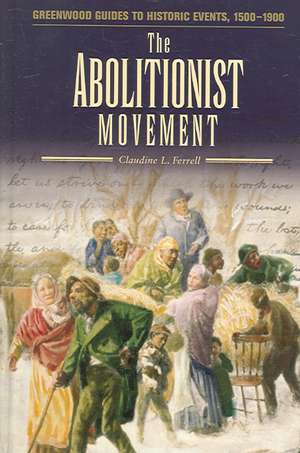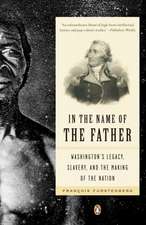The Abolitionist Movement: Greenwood Guides to Historic Events 1500-1900
Autor Claudine L. Ferrellen Limba Engleză Hardback – 29 dec 2005 – vârsta până la 17 ani
Din seria Greenwood Guides to Historic Events 1500-1900
- 42%
 Preț: 245.13 lei
Preț: 245.13 lei - 42%
 Preț: 248.24 lei
Preț: 248.24 lei - 42%
 Preț: 225.90 lei
Preț: 225.90 lei - 43%
 Preț: 168.53 lei
Preț: 168.53 lei - 42%
 Preț: 218.11 lei
Preț: 218.11 lei - 42%
 Preț: 227.73 lei
Preț: 227.73 lei - 42%
 Preț: 218.59 lei
Preț: 218.59 lei - 42%
 Preț: 203.72 lei
Preț: 203.72 lei - 42%
 Preț: 202.58 lei
Preț: 202.58 lei - 42%
 Preț: 246.65 lei
Preț: 246.65 lei - 42%
 Preț: 226.57 lei
Preț: 226.57 lei - 42%
 Preț: 223.48 lei
Preț: 223.48 lei - 42%
 Preț: 216.41 lei
Preț: 216.41 lei - 42%
 Preț: 236.29 lei
Preț: 236.29 lei - 42%
 Preț: 236.47 lei
Preț: 236.47 lei - 48%
 Preț: 247.38 lei
Preț: 247.38 lei - 42%
 Preț: 204.57 lei
Preț: 204.57 lei - 42%
 Preț: 218.40 lei
Preț: 218.40 lei - 41%
 Preț: 204.84 lei
Preț: 204.84 lei - 42%
 Preț: 319.67 lei
Preț: 319.67 lei - 51%
 Preț: 203.90 lei
Preț: 203.90 lei - 48%
 Preț: 237.23 lei
Preț: 237.23 lei
Preț: 223.48 lei
Preț vechi: 383.94 lei
-42% Nou
Puncte Express: 335
Preț estimativ în valută:
42.78€ • 46.48$ • 35.96£
42.78€ • 46.48$ • 35.96£
Carte tipărită la comandă
Livrare economică 21 aprilie-05 mai
Preluare comenzi: 021 569.72.76
Specificații
ISBN-13: 9780313331800
ISBN-10: 0313331804
Pagini: 248
Ilustrații: 14 bw illus
Dimensiuni: 156 x 235 x 24 mm
Greutate: 0.54 kg
Editura: Bloomsbury Publishing
Colecția Greenwood
Seria Greenwood Guides to Historic Events 1500-1900
Locul publicării:New York, United States
ISBN-10: 0313331804
Pagini: 248
Ilustrații: 14 bw illus
Dimensiuni: 156 x 235 x 24 mm
Greutate: 0.54 kg
Editura: Bloomsbury Publishing
Colecția Greenwood
Seria Greenwood Guides to Historic Events 1500-1900
Locul publicării:New York, United States
Notă biografică
CLAUDINE L. FERRELL is Associate Professor, History and American Studies, at Mary Washington College, and is the author of Reconstruction (Greenwood, 2003).
Cuprins
Series ForwardPrefaceAcknowledgementsChronology of EventsThe Abolitionist MovementHistorical Overview"In Matters of Right and Equity:" From Quakers to Revolution"Justice is in One Scale and Self-Perservation in tne Other:" Slavery and Anti-Slavery in the New Nation"Though the Heavens Should Fall:" Abolitionism Takes Shape--The 1830s"Contrary to the Laws of God and the Rights of Man:" Politics versus Spirituality--The 1840s"The Storm, the Whirlwind and the Earthquake:" From Politics and Violence to Freedom--The 1850s-1860sConcluding Interpretative EssayBiographies: Personalities of the Abolitionist MovementPrimary Documents of AbolitionismAnnotated BibliographyIndex
Recenzii
For high school students and college undergraduates, Ferrell traces the abolitionist movement from the early anti-slavery endeavors of the Quakers through the Civil War. She analyzes abolitionism during colonization and in the 1830s to 1860s, and discusses the efforts of churches, women, and blacks. Like the other volumes in the series, the book contains biographies of key figures such as Frederick Douglass and the Grimk'e sisters, primary source documents (such as articles of the Constitution, the Fugitive Slave Act, and the Emancipation Proclamation), and an annotated bibliography.











